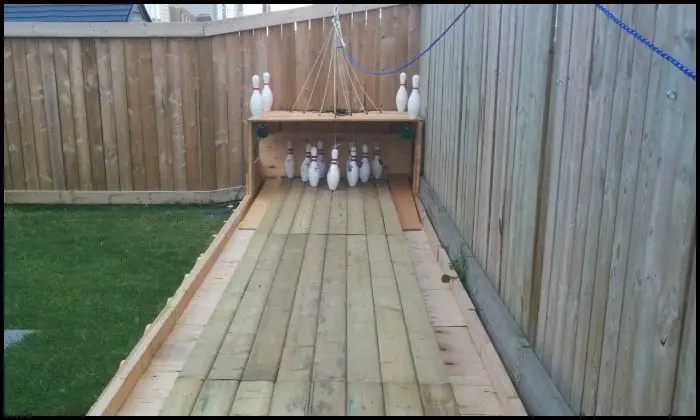
Whether you’re good at it or not, bowling is a fun thing to do with friends and family. But a session at an alley requires planning and isn’t a cheap outing! Why not build your own backyard alley you can use anytime?
Got enough space in your backyard? Then it’s definitely a build worth the effort if you’re a bowling enthusiast.
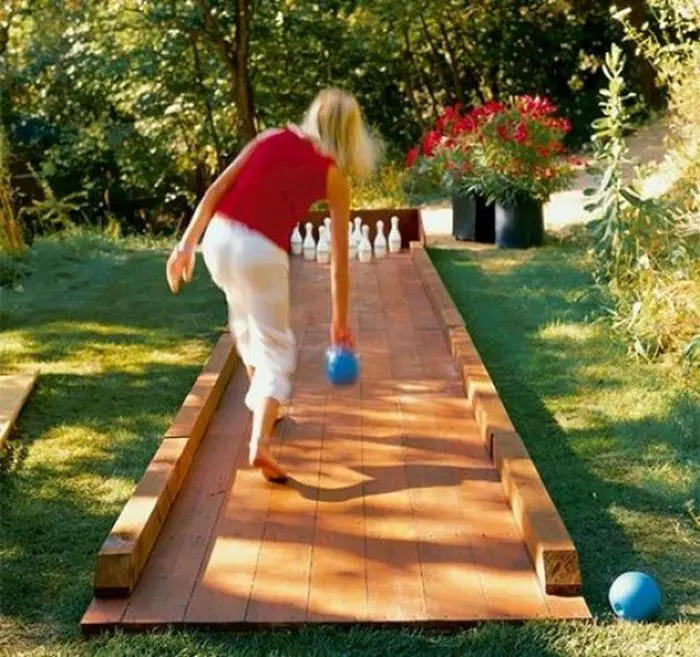
Or if you’re someone who loves hosting BBQ parties, this would be also be a great idea for entertaining your guests!

By making your very own bowling alley, you can now organize leagues right in your backyard! Just imagine the fun your friends and family will have with this DIY bowling alley. ;)
Do you know someone who would love this idea, too?
Contents
Building a Backyard Bowling Alley
Materials
- 2×6 Deck Board
- 4’x8′ 3/4″ Plywood
- Laminate Flooring
- Rubber Mat
- Deck Screws
- Strings
- Eye Hook
- Rope
- Pulley Hardware System
- Lighting
Tools
- Measuring Tape
- Table Saw
- Drill
- Leve
Instructions
Step 1: Plan Your Layout
- Measure the space in your backyard where you want to install the bowling alley. A standard lane is about 41 inches wide and 60 feet long, but you can adjust the dimensions based on your space.
- Sketch the layout, including where you’ll place the bowling lane and any additional features like seating or equipment storage.
Step 2: Prepare the Foundation
- Clear and level the ground where the lane will be installed. Use the spirit level to ensure the surface is flat.
- Lay down a layer of 2×6 deck boards as the base to provide a stable and level foundation. Secure the boards together using deck screws.
Step 3: Build the Frame
- Cut additional 2×6 deck boards to create the frame of your bowling lane. You’ll need two long sides and several shorter pieces for the ends and support across the width.
- Assemble the frame on the foundation, securing all pieces with deck screws.
Step 4: Install the Playing Surface
- Place the 4’x8′ plywood sheets over the frame to create the lane surface. Make sure the sheets are tightly aligned and secure them with deck screws.
- Cover the plywood with laminate flooring for a smooth, durable surface. The laminate should be cut to fit and then attached using an appropriate adhesive or according to the manufacturer’s instructions.
Step 5: Add the Pin Area
- At the end of the lane, install a rubber mat where the pins will be set. This helps to absorb impact and reduce noise.
Step 6: Install the Pulley System
- Install eye hooks at the end of the lane where the pins will be set and at the front where you’ll operate the system.
- Thread the rope through the pulley hardware system, connecting one end to the pinsetter mechanism and the other to a retrieval area.
- Test the pulley system to ensure it can smoothly set and retrieve the pins.
Step 7: Set Up Lighting
- Install lighting above the lane to ensure it can be used during evening hours. Ensure the lighting is evenly distributed and does not create glare on the surface.
Step 8: Final Touches
- Use strings to mark the boundaries and foul line of the lane.
- Test the entire setup by rolling a few balls down the lane to check for any irregularities or adjustments needed in the surface or the pulley system.
Step 9: Enjoy Your Bowling Alley
- Once everything is set up and tested, invite friends and family for a bowling game in your new backyard bowling alley!
Click on any image to start lightbox display. Use your Esc key to close the lightbox. ![]()
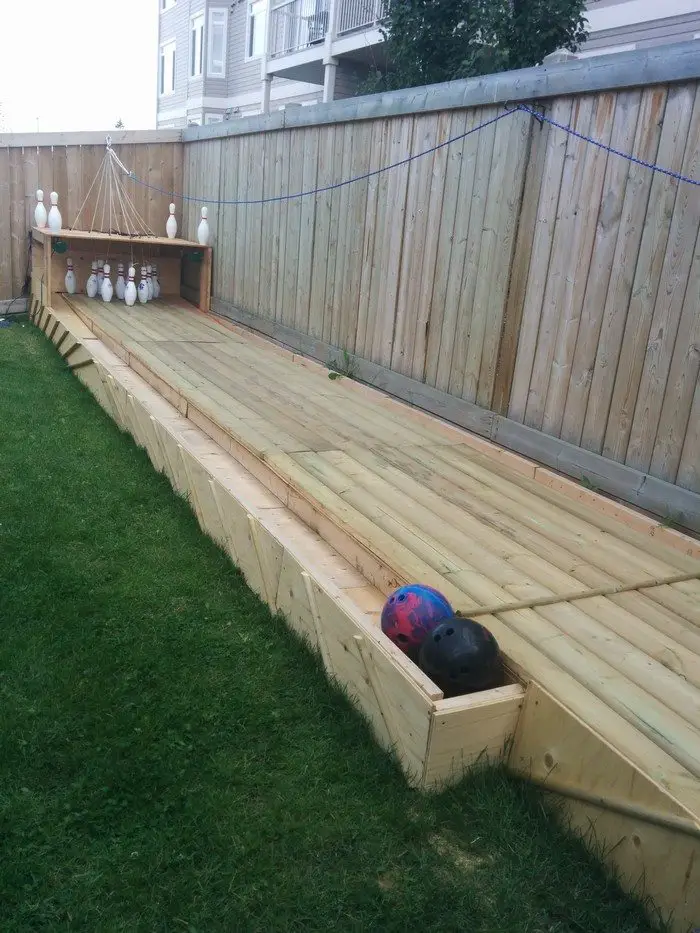

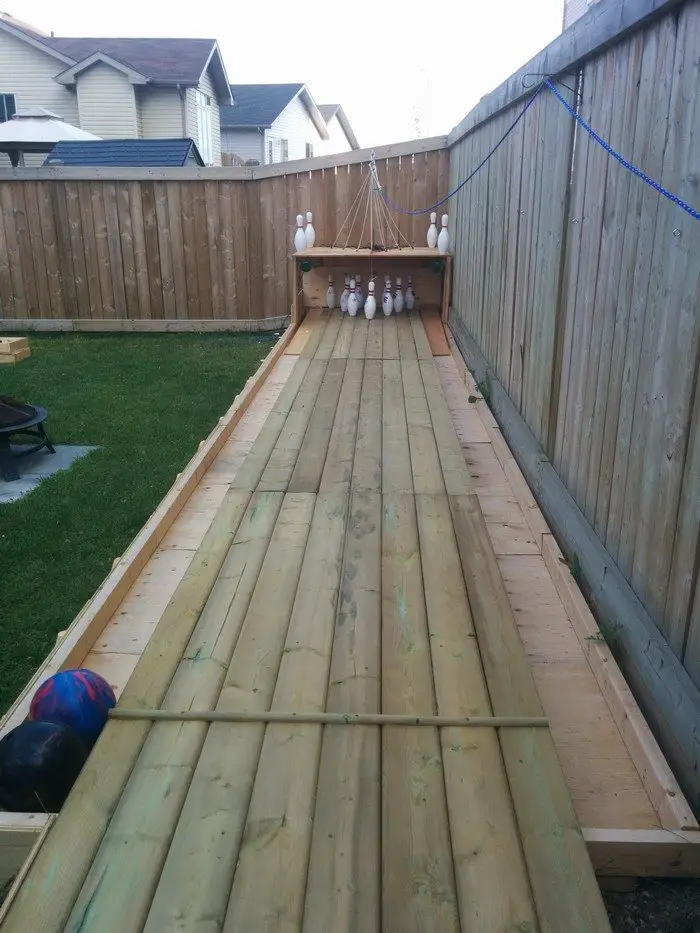

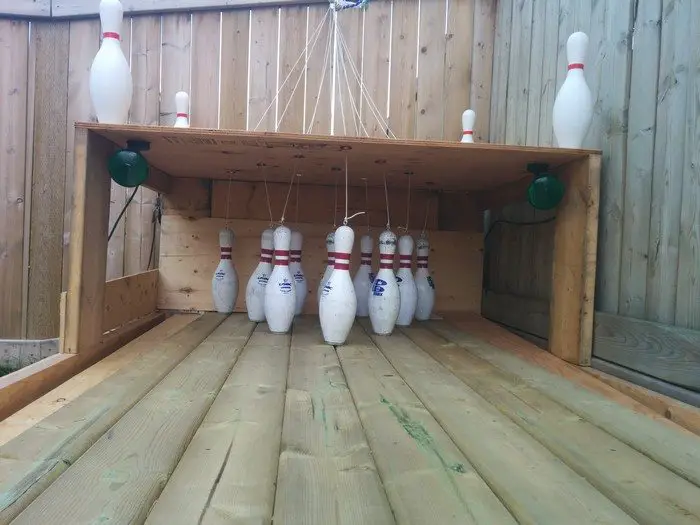

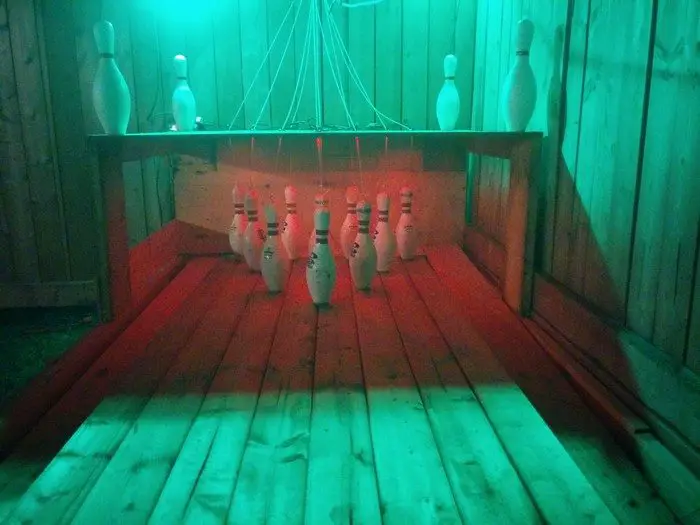


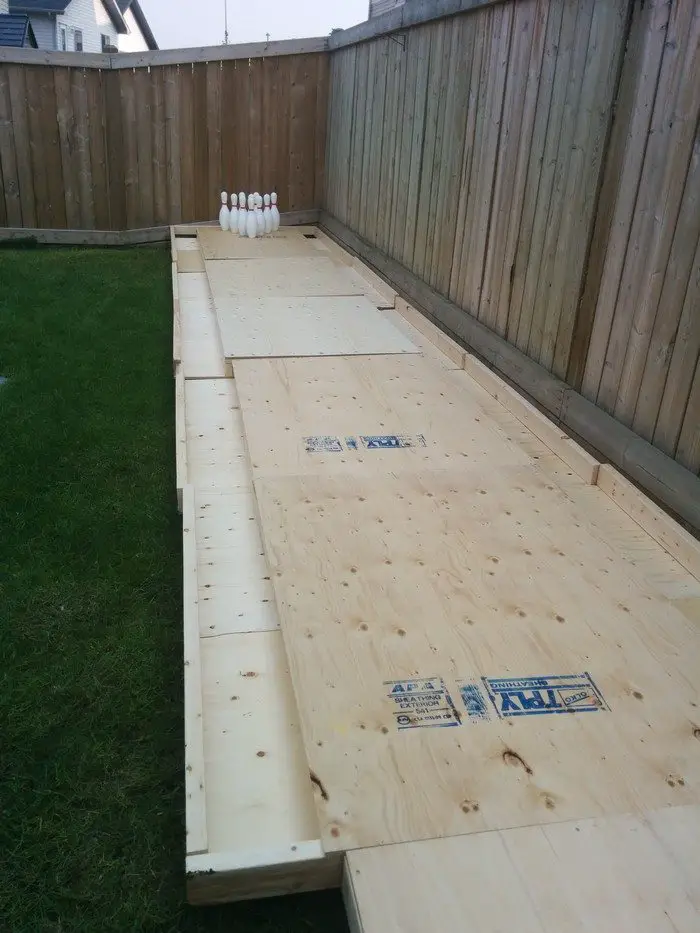

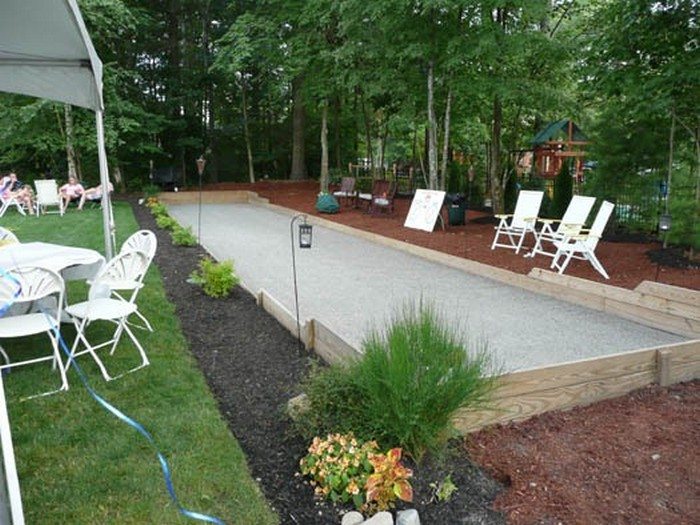
You can get more step-by-step instructions from Makgyver87 over at imgur…
Design Considerations and Layout Planning
Building a backyard bowling alley is an ambitious project that requires thoughtful planning to ensure it integrates seamlessly with your outdoor environment. This guide will cover key design considerations and layout planning tips to help you get started on your DIY adventure.
Choose the Right Location
The location of your backyard bowling alley is the first and most critical decision. Consider these aspects:
- Space Requirements: A standard bowling lane is about 60 feet long and 41 inches wide. Ensure you have enough space for the lane and additional room for players and spectators.
- Ground Level: The area should be as level as possible to minimize extensive groundwork. Uneven areas may require more preparation to create a stable foundation.
- Accessibility: Position the alley so it’s easily accessible from your house and consider how guests will move around the space without disrupting the game.
Consider Sunlight and Weather
The orientation of your backyard bowling alley can significantly impact playability:
- Sunlight: Avoid orienting the alley directly towards the sun’s path to prevent glare, which can affect visibility. North-south orientation is typically recommended.
- Weather Protection: Consider local weather conditions. If your area experiences frequent rain, think about drainage or even a cover system to protect the alley. For areas with intense sun, shading options can make the space more usable.
Integration with Outdoor Features
Integrating your backyard bowling alley with existing or planned landscape and hardscape features can enhance both aesthetics and functionality:
- Landscaping: Plan landscaping to complement the alley. Small trees or shrubs can provide shade and wind protection. Decorative borders can enhance visual appeal.
- Hardscaping: If you have existing patios or decks, consider how the alley can align with these structures for a cohesive look and functional flow.
Safety and Accessibility
Safety should always be a priority in the design of your backyard bowling alley:
- Surface Material: Choose materials that provide good traction and are smooth enough to allow bowling balls to roll well but are not too slick, reducing slip risks.
- Lighting: Ensure the area is well-lit not only for evening games but also for safety when moving around the space.
Compliance with Local Regulations
Before construction begins, check local zoning laws and building codes:
- Permits: Some regions may require permits for construction, especially if you’re planning significant alterations to your property.
- Noise Concerns: Be mindful of potential noise issues for neighbors, especially in densely populated areas.
Planning and designing a backyard bowling alley requires attention to detail and thoughtful consideration of the space and the needs of those who will use it. By addressing these key design and layout aspects, you can ensure your backyard bowling alley is a delightful addition to your home, providing endless fun and creating lasting memories.
Entertaining and Using Your Bowling Alley
Bowling alleys in backyards offer countless chances for social events and amusement. A big party, a friendly competition among friends, or a family game night—your bowling alley can be the centre of excitement and pleasure.
Organize Regular Bowling Nights
Organizing frequent bowling nights is one of the greatest ways to enjoy your backyard bowling alley. Organise a weekly or monthly timetable and extend an invitation to friends and family. Along with being a terrific social activity, this maximizes your investment.
Host Tournaments and Leagues
Organise competitions or launch a little league in your backyard bowling alley to maximise the enjoyment. Teams can be formed, results kept during the season, and even tournament awards can be given out. This is a terrific approach to encourage healthy rivalry and keep players excited about the upcoming game.
Combine Bowling with Other Backyard Activities
Maximize the entertainment potential of your backyard by combining bowling with other activities. If you have a pool, BBQ grill, or fire pit, arrange events where these features are integrated with bowling. For instance, you could have a BBQ day with a bowling competition as the main event in your backyard bowling alley.
Family Fun Days
Your backyard bowling alley is a perfect setting for family gatherings. Organize a family fun day where everyone, from kids to adults, can enjoy a game of bowling. Include other family-friendly activities and games to keep everyone engaged. It’s a great way to create cherished family memories.
Themed Parties
Themed parties can bring an extra level of excitement to your backyard bowling alley. Host a retro bowling night, a Halloween bowl, or a summer bowling bash with appropriate decorations, costumes, and themed food and drinks. This not only makes the event more memorable but also allows for creative uses of your bowling alley.
Safety and Comfort Measures
To ensure that everyone enjoys their time at your backyard bowling alley, consider implementing safety and comfort measures. Adequate lighting for evening games, comfortable seating areas for spectators, and safety protocols are important. Make sure the alley is well-maintained and equipped with basic first aid in case of accidents.
Your backyard bowling alley can serve as a versatile and enjoyable entertainment area. With regular use, themed events, and combined activities, it can become a beloved part of your home. Whether it’s hosting a competitive tournament or a casual game night, the fun and enjoyment it brings makes every moment spent there worthwhile.
Conclusion
Adding a backyard bowling alley is a fun and distinctive way to enhance your house and make enduring memories. Everyone can enjoy the flexible entertainment area that is the outcome of the project, which does need some elbow grease and meticulous planning. Accept the challenge and before long you’ll have a useful and enjoyable bowling alley in your own backyard.





